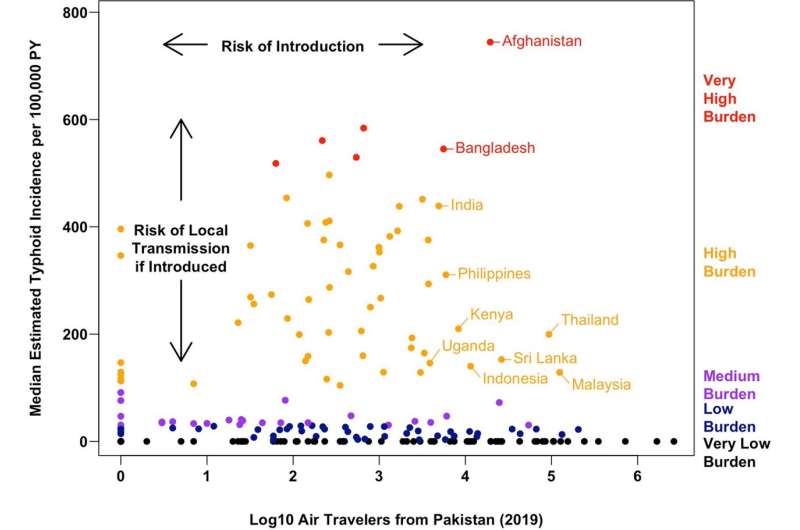This article has been reviewed according to Science X's editorial process and policies. Editors have highlighted the following attributes while ensuring the content's credibility:
fact-checked
peer-reviewed publication
trusted source
proofread
Study identifies countries vulnerable to extensively drug-resistant typhoid

Using air travel records and data on where local conditions make transmission more likely, Yale School of Public Health (YSPH) researchers have identified countries where outbreaks of an extensively drug-resistant form of typhoid fever are most likely to occur. The research, published in Nature Communications, could help prevent and control additional outbreaks.
Typhoid fever is caused by the bacterium Salmonella Typhi. It sickened 9 million people and killed 110,000 in 2019, according to the World Health Organization. Children are most vulnerable.
An extensively drug-resistant (XDR) strain of S. Typhi emerged in 2016 in Pakistan and has since become the most common strain in the country. XDR S. Typhi is resistant to all antimicrobials except for one orally administered antibiotic and has so far only caused large outbreaks in Pakistan. Intravenous antibiotics are effective, but are expensive and require hospitalization, which can make them unfeasible for some countries' health systems.
Drug resistance in typhoid treatment has been a problem since the early days of antibiotics, said Jo Walker, the paper's first author and a YSPH doctoral student who led the research under guidance from Virginia Pitzer, an associate professor of epidemiology (microbial diseases).
"Multiple rounds of new drugs have been discovered and developed and put into use, but then we see resistance pop up," Walker said. "This has continued repeatedly over time."
Typhoid vaccines exist but until recently had not been available for younger children, required several doses or boosters, and had an efficacy rate as low as 50%, according to Take on Typhoid, a joint project of the Coalition against Typhoid and the Typhoid Vaccine Acceleration Consortium. Typhoid conjugate vaccines solve these problems, and two have been approved for use, but more needs to be done for them to be used broadly, according to the consortium where Pitzer is a member and lead modeler.
Scientists and public health officials are concerned XDR S. Typhi could spread to other countries, making it much harder to treat typhoid fever globally, Walker said.
"Our impetus for this project was to get out ahead of those possible future outbreaks and try to identify the settings where some preemptive actions could be taken to slow the spread or stop outbreaks before they happen," they said.
To do this, the team studied the volume of air travel from Pakistan to other countries in 2019 and reported cases of XDR typhoid. Countries with XDR cases had a median of 84,507 air travelers from Pakistan, while countries without XDR S. Typhi had a median of only 252. Of the 10 countries that had the most air travelers from Pakistan, seven reported cases of XDR typhoid.
Because typhoid fever is spread through water and food being contaminated with feces containing S. Typhi, it is unlikely to cause outbreaks in countries with high levels of sanitation and clean water.
To better understand where efforts should be concentrated, the researchers cross-referenced the rate of incoming air travel from Pakistan against three sets of estimates of countries' annual typhoid fever cases to find those most likely to have a major outbreak or sustained transmission of XDR S. Typhi.
The top 10 must vulnerable countries identified in the analysis were Afghanistan, Bangladesh, India, Sri Lanka, Indonesia, Malaysia, the Philippines, Thailand, Uganda, and Kenya. Afghanistan could be particularly vulnerable due to its very high typhoid fever burden, high rate of travelers from Pakistan, and health and humanitarian crises, the researchers note.
Pitzer, the paper's senior author, said the findings could be used for more targeted research by international health agencies such as Gavi, the Vaccine Alliance, which has supported typhoid conjugate vaccine development. But they would perhaps be best used by health systems within vulnerable countries, she said.
"The paper's targeted toward people in the ministries of health in these high-risk countries so that they are aware that this is potentially a problem," said Pitzer. "Ultimately, demand for typhoid conjugate vaccines needs to come from the countries, and a lot of the surveillance effort typically also needs to come from countries."
More information: Joseph Walker et al, Assessing the global risk of typhoid outbreaks caused by extensively drug resistant Salmonella Typhi, Nature Communications (2023). DOI: 10.1038/s41467-023-42353-9




















